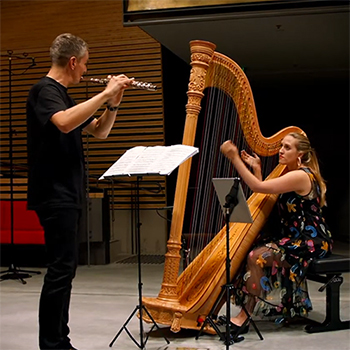
Emily Granger on the Birth of New Music
American harpist Emily Granger effortlessly straddles the worlds of classical and popular music. As a champion of new music who is passionate about broadening the harp repertoire, Emily tells us why she loves working with composers and shares an insight into her upcoming show Digital Debussy.
I love working with composers.
Maybe it’s because it is so exciting to play a part in the creation of something new. Or maybe it’s because I so often perform the music of composers who have been dead for centuries. Nonetheless, getting to be in on the ground floor with a brand-new piece of music and to have the privilege of giving the world premiere is something very special.
My relationship with composers tends to go far beyond the traditional exchange of performer commissions composer; composer writes piece; performer performs the piece.

The harp is a misunderstood instrument – and with more than 2000 moving parts and a range of close to seven octaves, I’m not surprised.
Many composers write music that is impossible to play, wrongly assuming that our instrument is similar to the piano, or conversely, it is undermined through writing that is too simplistic – typically in one register – and missing out on all the resonance that makes the harp so unique. In my case the composer writes the initial draft (which is never exactly what will be performed at the premiere), followed by many drafts, lots of back and forth, and trial and error.
The program for Digital Debussy includes a new work by Sydney-based composer Tristan Coelho. Tristan composes a vast range of interesting and diverse music including a high volume of harp music – in part because he’s also my fiancé. Our working relationship is very special as Tristan lives in a home with a harp and understands intimately what goes into the mechanics and technique of playing the harp.
This new work is for my favourite chamber ensemble: harp, flute, and viola.
An ethereal combination of winds and strings, with the harp acting like the glue to this dreamy ensemble. In Tristan’s work, he has added another textural layer incorporating live electronics. The work is based on Claude Debussy’s Sonata and Toru Takemitsu’s And then there t’was wind. Tristan has selected fragments of these two pieces and interweaves these with electronic sounds adding a new dimension that gives us the title of this program, Digital Debussy.
It’s a tough act to follow in the footsteps of composers like Debussy and Takemitsu, but I am certain that this new work will bring something new to the table and stand out as an important work in the repertoire for harp, flute, and viola. I can’t wait to share this piece with audiences soon.

